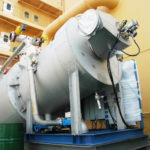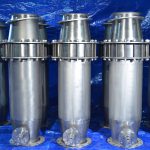The spread of invasive species is recognised as one of the greatest threats
to the ecological and economic well-being of the oceans. Coldharbour Marine has developed a ballast water management systems (BWMS) which is especially suitable for VLCCs and gas tankers
Global economic losses caused by harmful species were estimated in 2004/5 to exceed 7bn$ annually. In 2004 the International[ds_preview] Maritime Organization’s (IMO) Convention on the Control and Management of Ships’ Ballast Water and Sediments became the instrument to prevent the world wide spread of harmful invasive species in unmanaged ballast water, but at that point no equipment existed that would help ship owners or operators manage the problem.
Where do you start to develop a totally new set of technologies capable of treating many thousands of gallons of ballast water to ensure that no potentially invasive organisms can be transported around the world to contaminate new environments? That was the challenge accepted and overcome by marine engineers Coldharbour Marine.
Coldharbour addressed the challenge by undertaking a »customer insight« exercise. This identified the three most important characteristics of an ideal Ballast Water Treatment System (BWTS) and twelve secondary characteristics. Customers told Coldharbour that the ideal BWMS would have:
-minimal disruption on operations
-not require other equipment to be replaced/upgraded
-minimal impact on power generation capacity
-no filters to block
-allow gravity ballasting/deballasting
-be simple to use
-be robust and reliable
-be small
-have low running costs
-cause no damage to tank coatings, vessel structures or systems
-be future proof
-involve no active chemicals
-be safe, even if misused
-eliminate the risk of regrowth on long voyages
This became the design brief.
Coldwater’s BWMS is a space saving, in-tank solution. LPG and LNG tankers already carry Inert Gas Generators (IGG) to produce deoxygenated gases to blanket cargoes, this generator doubles up in the BWMS and forms its first element. Once any necessary cargo gasification has been completed, the IGG is switched over and linked via pipework to a series of Gas Lift Diffusion (GLD) units mounted inside each ballast tank. The GLDs use natural fluid dynamics to stir inert gas through the ballast water, ensuring thorough treatment.
Three ways of treatment
The inert gas reduces the ballast water’s oxygen level while its elevated CO2 dissolves and lowers the water’s pH. As the gas passes through the GLD it generates ultrasonics which physically disrupt the cell walls of any aquatic organisms present, gas micro-bubbles form and cavitate, amplifying the ultrasonic effect. Thus ballast organisms are killed in three ways: by hypoxia, caused by low levels of O2, by hypercapnia caused by the low pH/dissolved CO2 and by ultrasonic cell wall disruption ballast water treatment technologies can be divided into G8 mechanical-physical and G9 chemical methodologies, practically all use a combination of processes. Step one in competing technologies is the mechanical separation of particles performed by filters or hydrocyclones. However, filters are vulnerable to blockages and both techniques are very power hungry, particularly disadvantageous for tanker operators managing high ballast water volumes.
The range of physical treatments used in BWMS embraces ultrasound and cavitation (as with Coldharbour Marine): heat treatment and treatment with U.V. irradiation. These latter approaches have evolved from land based technologies and are highly energy demanding. Alternative U.V. systems damage DNA making organisms unable to reproduce but not necessarily killed. These systems are unusable in turbid water or in water with high levels of dissolved organic matter since both limit U.V. penetration. These BWMS treat water as it is brought aboard prior to being pumped into the ballast tanks, usually at terminals just when the pressures on crew and systems are at the maximum. Any problems at this stage can prove extremely costly even triggering demurrage charges if the terminal time is overrun. The Coldharbour approach is free of these problems.
No toxins
Alternative chemical G9 systems, which use active substances, rely on disinfectants that inhibit biological processes by reacting with organisms’ biomolecules. The main active entities are oxidizing agents. Systems based on chlorine (either generated in situ by seawater electrolysis or from hypochlorite stock-solutions) predominate, followed by systems using ozone, peracetic acid or chlorine dioxide. There are a number of reports of toxins being found in treated ballast water resulting from disinfection by-products, which are ultimately discharged into the ocean, in the waste ballast. These toxins cause genetic damage and ultimately will impact negatively on biodiversity. The long term consequences of chemical treatments are as yet unknown. But, as the sorry history of DDT in the environment illustrates, the introduction of active chemical entities can bring serious long term impacts.
Coldharbour’s innovative approach to marine engineering brings a number of benefits to the ship owner and operator. IGG technology is already well understood and Coldharbour’s IGG is small, reliable, clean in operation and requires little maintenance because Coldharbour’s BWTS treats water in the ballast tanks it functions without filters, membranes, active substances or electrical connections. Water temperature, salinity, and water quality (suspended solids) have no impact on this BWTS performance and, by operating when the ship is underway, crew are unhindered at terminal and can focus on port duties/essential maintenance. With a small physical footprint, Coldharbour’s ancillary equipment can be installed anywhere suitable. Based upon established marine technology with few moving parts, the Coldharbour BWMS requires minimal maintenance or staff training.
Once designed and patented, Coldharbour Marine had the system tested by a University of Oxford biologist before a prototype was submitted for IMO accreditation on shore and on ship. Because uniquely, the system operates in the tanks during the voyage rather than at the terminal, the assumptions underlying early IMO accreditation processes proved invalid and new tests had to be developed.
In 2012, the Coldharbour GLD technology was the first BWTS ever to be retrofitted to a 309,000 dwt VLCC (Very Large Crude Carrier) and it was on this vessel that ship testing was completed in 2014 under the watchful eyes of Lloyd’s Register (LR). As a British company, Coldharbour was keen that the UK MCA, which used LR to independently audit both land and sea tests, accredit their system.
As Chief Executive, Andrew Marshall, explained, »We were keen that UK MCA undertook the Type Approval. UK MCA has a worldwide reputation for rigour, thoroughness and probity that will be welcomed by owners and operators who need to have confidence in their choice of BWTS. USCG AMS approval was achieved in May 2015 and, because of the additional effort we invested in our UK MCA/IMO testing, we are very well placed to move forward to full USCG Type Approval within a reasonable timeframe.«
Now tanker operators have access to a system with no electrical parts to fail, which operates in voyage not at terminal saving time and costs and which avoids any risk of regrowth. The system with its three kill strategies – hypoxia, hypercapnia and ultrasonic cavitation, leaves no chemical residue and operates in any type of water – fresh to the most saline, clear or turbid and independent of temperature.
In short, by focusing on the needs of customers and believing that one size does not fit all, Coldharbour, has produced the optimal system for tanker and bulk carrier operators who otherwise will struggle to manage large volumes of ballast water at high pump rates.
Rosie Featherstone




















